| 11-07-2016 | Michiel van den Broek |

Alhoewel de grootste financiële crisis ooit al weer acht jaar is geleden, overspoelen toezichthouders de bankensector nog steeds met nieuwe regulering. In dit artikel vindt u een overzicht van een aantal nieuwe maatregelen en voorstellen, officieus bekend als Bazel’s Akkoord 4.
Achtergrond Bankentoezicht: BIS Ratio en Leverage Ratio
De kern van het bankentoezicht bestaat uit adviezen van het Basel Committee of Banking Supervision, beter bekend als het Bazel’s Comité, dat is opgezet in 1975 op initiatief van de Bank of International Settlements (BIS). Deze eisen betreffen hoofdzakelijk kapitaalbuffers om onverwachte verliezen op te kunnen vangen.
Tot 2008 zijn deze buffers alleen gebaseerd op ingeschatte risico’s die zijn omgerekend naar risico-equivalenten: de Risk Weighted Assets (RWA). Deze zogenaamde BIS Ratio is onderdeel van Bazel akkoord II pijler 1 van 2007, vereist een minimum kapitaalbuffer van 8% van RWA,.
Omdat het inschatten van risico’s een subjectieve component bevat, is er in Bazel III akkoord van 2010 een aanvullende kapitaaleis bepaald die ingaat per 1 januari 2018: de Leverage Ratio. Deze Leverage Ratio houdt in dat banken minimaal 3% kernkapitaal moeten aanhouden gerelateerd aan het balanstotaal zonder risicoweging, inclusief ongebruikte kredietlijnen en garanties. Onze regering heeft de woede bij Nederlandse grootbanken opgewekt door een hogere Leverage Ratio van 4% te eisen. Als u verder leest zult u begrijpen dat nieuwe regelgeving deze woede inmiddels heeft ‘ingehaald’.
Aanpassen Standaardmethode RWA Kredietrisico
In december 2015 heeft het Bazel’s Comité in document d347 nieuwe voorstellen gedaan ter aanpassing van de RWA bepaling bij kredietverlening via de standaardmethode. Bij deze voorstellen zijn vooral de volgende twee aanpassingen belangrijk.
In de eerste plaats moeten banken bij kredietverlening de risicoweging onderbouwen via een eigen onderzoek, een ‘due dilligence’. Deze aanpassing leidt tot extra lastendruk voor de kredietafdelingen van banken.
Ten tweede zal bij onroerendgoedfinanciering niet meer het betalingsgedrag van de klant bepalend zijn voor het kapitaalbeslag, maar de hoogte van het krediet ten opzichte van de waarde van het onroerend goed, oftewel ‘Loan To Value’ (LTV). Omdat Nederlandse grote banken internationaal gezien zeer grote hypotheekportefeuilles hebben, waarvan een groot deel met een hoge LTV, zal deze aanpassing tot een substantiële extra kapitaalverhoging leiden zijn in vergelijking tot buitenlandse concurrenten.
Aanpassen Standaardmethode RWA Operationeel risico
Banken kunnen aanzienlijke verliezen lijden als gevolg van fouten, fraude en haperende automatisering. De kapitaaleisen voor deze operationele risico’s zijn tot op heden gebaseerd op de omzet en / of het renteresultaat. Het is niet zo moeilijk om een vraagteken bij te zetten bij deze werkwijze. Immers, waarom zou er minder kapitaal voor operationele risico’s moeten zijn als de omzet lager is?
In oktober 2014 is via voorstel bcbs291 een nieuwe standaardmethode aangekondigd waarbij het kapitaal voor operationeel risico wordt berekend via een coëfficiënt die afhangt van de hoogte van een Business Indicator (BI). Deze BI is bepaald via een voorgeschreven model met als input drie elementen: (1) Interest, (2) Services en (3) Financial.
Hiernaast is in voorstel d355 van maart 2016 aangekondigd dat banken in de toekomst hun eigen modellen, de Advanced Measurement Approach (AMA), niet meer mogen gebruiken ter berekening van het kapitaalbeslag voor operationeel risico’s.
Mijn inschatting is dat in de toekomst alle kapitaaleisen gebaseerd zullen zijn op door de toezichthouder voorgeschreven standaardmethoden en dat het gebruik van door banken ontwikkelde eigen modellen niet meer is toegestaan, zoals de bij grote banken populaire Internal Rating Based (IRB) modellen voor kredietrisicoweging.
Nieuwe kapitaaleisen van FSB en EBA: TLAC en MREL
De Financial Stability Board (FSB) en European Banking Authority (EBA) hebben in 2015 aanvullende kapitaaleisen gesteld om de financiële stabiliteit van banken te verhogen. Deze voorstellen bevatten 2 elementen: (1) meer kapitaal en (2) een bail-in schuldklasse.
De FSB kapitaaleis betreft Total Loss Absorbing Capacity (TLAC) en is van toepassing op de 30 grootste systeembanken ter wereld, de Global Systematically Important Banks (G-SIB’s). TLAC is onderdeel van de toezichtpijler 1 van de Bazel III kapitaaleisen. De invoering van TLAC vindt plaats in twee fases. Per 1 januari 2019 moeten G-SIB’s tenminste 16% RWA kapitaal aanhouden, exclusief het kernkapitaal voor Capital Conservation en G-SIB’s, alsmede een Leverage Ratio van minimaal 6%. Per 1 januari 2022 zijn de minima 18% RWA en 6,75% Leverage. Ook moet tenminste 33,3% van het TLAC kapitaal bestaan uit componenten die niet tot het kernvermogen (Core Equity Tier 1 – CET 1) behoren.
De EBA heeft gelijksoortige eisen gesteld voor alle Europese banken, de Minimum Requirement for own funds and Eligible Liabilities (MREL). Zowel TLAC als MREL zijn ontstaan om overheidssteun bij een bankroet zoveel mogelijk te voorkomen. Om te vermijden dat TLAC en MREL tot tegenstrijdige en stapelende regelgeving leidt, is de algemene verwachting dat de TLAC kapitaaleisen zullen worden geïntegreerd in MREL bij de evaluatie door de EBA eind 2016.
Een belangrijk verschil met TLAC, is dat MREL behoort tot toezichtpijler 2 van de Bazel III kapitaaleisen, hetgeen betekent dat nationale toezichthouders per bank beoordelen hoeveel extra kapitaal vereist is boven de pijler 1 buffers. MREL zal per Europees land nog in nader te bepalen wetgeving moeten worden geïmplementeerd. Hoe deze wetgeving met betrekking tot de bail-in schuldklasse uitwerkt zal per land kunnen verschillen. Zo zijn in Italië een groot deel van de achtergestelde schuldtitels in particulier bezit. Italiaanse politici zullen waarschijnlijk willen vermijden dat zij de electorale rekening zullen moeten betalen als een bank omvalt en dus particulieren buiten de bail-in schuldklasse proberen te houden.
Ondertussen ontstaat er al meer duidelijkheid voor beleggers doordat er inmiddels op de kapitaalmarkt een nieuwe klasse van bail-in schuldtitels wordt aangeboden. Een recent voorbeeld van deze nieuwe klasse is de emissie van Senior Resolution Notes door de Deense bank Nykredit’s.
Ten slotte
Afsluitend constateer ik dat historisch gezien er een herhaling van zetten gaande is. Net als na de implosie van het financiële systeem volgend op de beurskrach van 1929, draaien ook nu toezichthouders de duimschroeven weer stevig aan bij banken. Het is te hopen dat de les nu definitief is geleerd: een te vergaand geliberaliseerde bankensector leidt tot financiële en economische misère.

Michiel van den Broek
Owner of Hecht Consult
 Almost 3 months ago, treasuryXL went live. Not knowing how people would respond, we pushed the buttons and worked our hardest to make treasuryXL a success. Since then we’ve learned something new everyday by publishing fresh content everyday and keeping in contact with you, the treasury community. I’m really proud of what we have reached so far and we will continue to improve treasuryXL. Your ideas and suggestions are always welcome!
Almost 3 months ago, treasuryXL went live. Not knowing how people would respond, we pushed the buttons and worked our hardest to make treasuryXL a success. Since then we’ve learned something new everyday by publishing fresh content everyday and keeping in contact with you, the treasury community. I’m really proud of what we have reached so far and we will continue to improve treasuryXL. Your ideas and suggestions are always welcome! Stephanie Derkse – Community Manager
Stephanie Derkse – Community Manager






 An increasing number of bankers come to my recruitment desk wanting to make a transfer to corporate treasury. This transfer can be made successfully but there are a number of things to take into account. Below the 8 career hurdles, I hear most about, in a transfer from banking to corporate treasury.
An increasing number of bankers come to my recruitment desk wanting to make a transfer to corporate treasury. This transfer can be made successfully but there are a number of things to take into account. Below the 8 career hurdles, I hear most about, in a transfer from banking to corporate treasury. 
 De afgelopen week zijn er grote verschillen gezien in de koers van de Britse pond na de uitslag van het referendum. In januari 2015 werd de markt ook al eens verrast door een onverwachte gebeurtenis: De Zwitserse Centrale Bank (SNB) veroorzaakte toen een schokgolf met het onverwacht loslaten van de ‘peg’ tussen de EUR en de CHF.
De afgelopen week zijn er grote verschillen gezien in de koers van de Britse pond na de uitslag van het referendum. In januari 2015 werd de markt ook al eens verrast door een onverwachte gebeurtenis: De Zwitserse Centrale Bank (SNB) veroorzaakte toen een schokgolf met het onverwacht loslaten van de ‘peg’ tussen de EUR en de CHF.  René Schilder – Co Owner at 2FX Treasury BV
René Schilder – Co Owner at 2FX Treasury BV
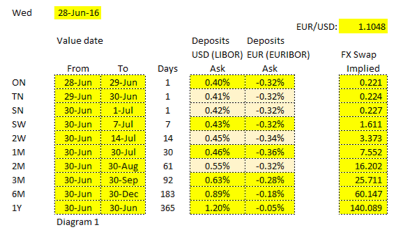 Now if we would consider exchanging a USD deposit versus a EUR deposit for 1 year the cash flows would be as follows:
Now if we would consider exchanging a USD deposit versus a EUR deposit for 1 year the cash flows would be as follows: e are looking at a single day FX swap, the annualized rate could swing a lot.
e are looking at a single day FX swap, the annualized rate could swing a lot.
 A normal yield curve is usually upward sloping with diminishing increases in yield– the longer the tenor, the higher the interest rate. Generally it is assumed that longer maturities contain larger risks for lenders and they require adequate compensation with a risk premium in the form of a liquidity spread.
A normal yield curve is usually upward sloping with diminishing increases in yield– the longer the tenor, the higher the interest rate. Generally it is assumed that longer maturities contain larger risks for lenders and they require adequate compensation with a risk premium in the form of a liquidity spread.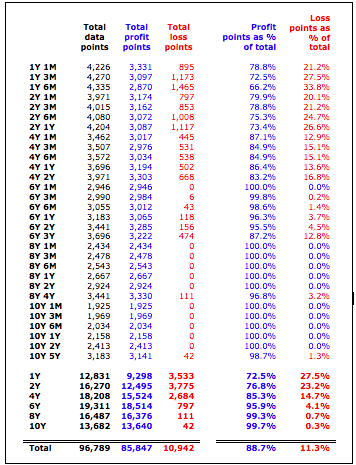
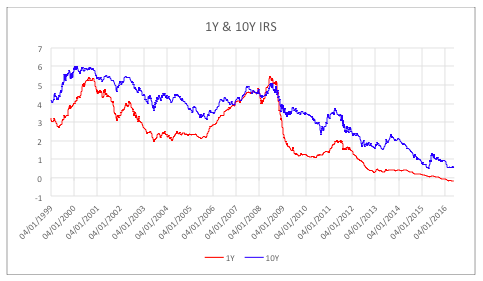
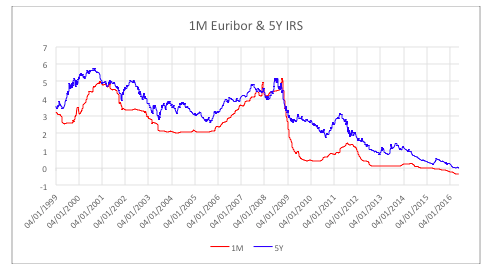
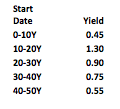
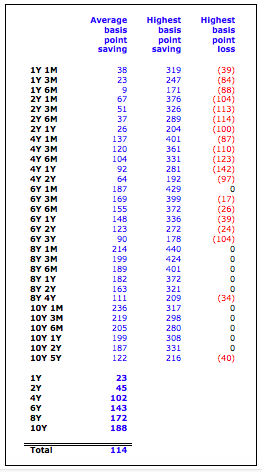


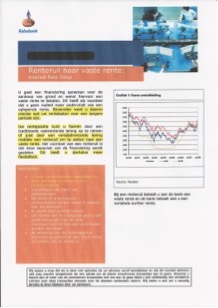 “Bijgaand de standaardteksten bij de advisering/verkoop van een renteswap door de Rabobank. Let op het verschil van 2008 en 2010! In 2008 is het structureel verkocht door te stellen dat de klant ‘een vaste rente gaat betalen’.
“Bijgaand de standaardteksten bij de advisering/verkoop van een renteswap door de Rabobank. Let op het verschil van 2008 en 2010! In 2008 is het structureel verkocht door te stellen dat de klant ‘een vaste rente gaat betalen’.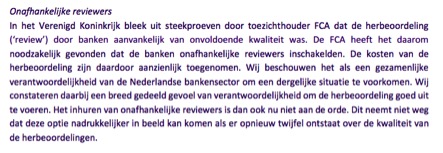

 Already over a decade the treasury community agrees that the modern treasurer does not act out of an ivory tower. Still, a lot of the treasury stories about funding, I hear in treasury recruitment, are about technical details. I learn in detail about USPP’s, interest hedging strategies and convertible bonds. Between these technical stories I notice other ones. I think they are inspiring and would like to share two of them.
Already over a decade the treasury community agrees that the modern treasurer does not act out of an ivory tower. Still, a lot of the treasury stories about funding, I hear in treasury recruitment, are about technical details. I learn in detail about USPP’s, interest hedging strategies and convertible bonds. Between these technical stories I notice other ones. I think they are inspiring and would like to share two of them.
